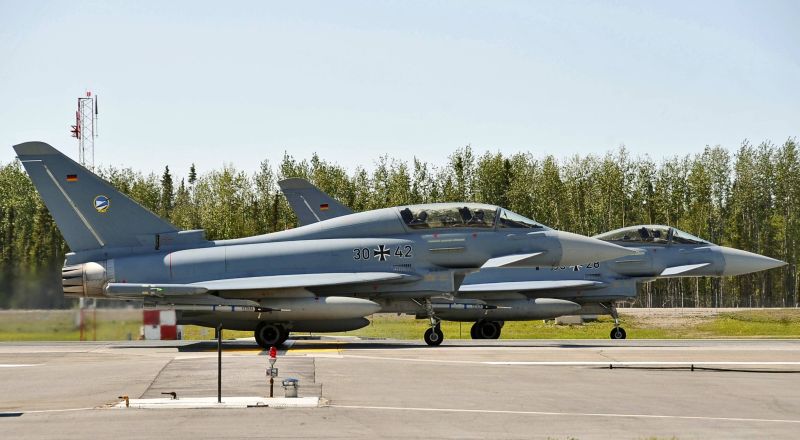Eight Eurofighter Typhoon aircraft from German Air Force Jagdgeschwader 74 (JG 74) took part in a two week ‘Red Flag’ exercise in Alaska alongside American, Polish, Japanese and Australian air forces. Eurofighter Typhoons were deployed from their home base in Neuburg, Southern Germany, to Eielson Air Force Base to participate in the internationally renowned exercise.
Red Flag, which lasted from 11th until June 22nd, provided an opportunity for the participating nations to gain invaluable experience in tactical missions, collective defence and conflict management. Fighter Wing JG 74 took part in the exercise in readiness for its assignment to the NATO reaction force this year, assuring the unit has the right level of interoperability and capabilities for such a role.
Marc Grüne, Lt. Col. of Fighter Wing 74, said: “The German Air Force’s decision to take part in exercise Red Flag – Alaska offered a great opportunity for Fighter Wing 74 to train, test and improve personal skills and aircraft capabilities. We wanted to see if the Eurofighter is capable of everything we think it is. And the aircraft is definitely capable. The challenging tasks and tough working days have brought the best out of everyone because of the spirit and passion of the people.”
Red Flag participants are organised into “Red” aggressor forces and “Blue” coalition forces. The Red force included air-to-air fighters, ground-control intercept, and surface-to-air defence forces to simulate threats posed by potentially hostile nations. These forces employed defensive counter-air tactics directed by ground-control intercept sites. Range threat emitters – electronic devices which send out signals simulating anti-aircraft artillery and surface-to-air missile launches – provide valuable surface-to-air training. The Blue force – of which the JG 74 Eurofighter Typhoons were part – included the full spectrum of U.S. and allied tactical and support units.
During the two-week employment phase of the exercise, the JG 74 Typhoons flew 98 of the planned 102 sorties. Aircrews were subjected to every conceivable combat threat. Scenarios were shaped to meet each exercise’s specific training objectives. Typically about 70-90 jets are flying at the same time in one of the two daily so called waves. The exercise has a building block approach, where mission difficulty will increase to a point where up to about eighteen threat aircraft will present a highly capable, modern opponent.
The commander of Fighter Wing 74, Col. Andreas Pfeiffer, said of the exercise: “If you put all of the factors together, this is probably the highest quality training you could possibly get in modern air combat.”
The deployment of the eight Neuburg based Eurofighter Typhoons to Eielson Air Force Base set a new milestone in the history of the German Air Force with the 8,000 kilometre, ten hour Atlantic crossing to the Alaskan base, located 42 kilometres south east of Fairbanks. The Eurofighter Typhoons made the trip in groups over two days, supported by two German MRTT A310 tankers and demonstrated again the ease of deployability over long distances.
Background information
Eurofighter Typhoon is the world’s most advanced new generation real multi-role/swing-role combat aircraft available on the market and has been ordered by six nations (Germany, Italy, Spain, United Kingdom, Austria and the Kingdom of Saudi Arabia).
With 707 aircraft on contract and 559 aircraft ordered, it is Europe’s largest military collaborative programme and delivers leading-edge technology, strengthening Europe’s aerospace industry in the global market. More than 100,000 jobs across 400 companies are secured by the programme.
Eurofighter Jagdflugzeug GmbH manages the programme on behalf of the Eurofighter Partner Companies: Alenia Aermacchi/Finmeccanica, BAE Systems, EADS CASA and EADS Deutschland, Europe’s foremost aerospace companies with a total turnover of approx. €123.2 billion (2011).









